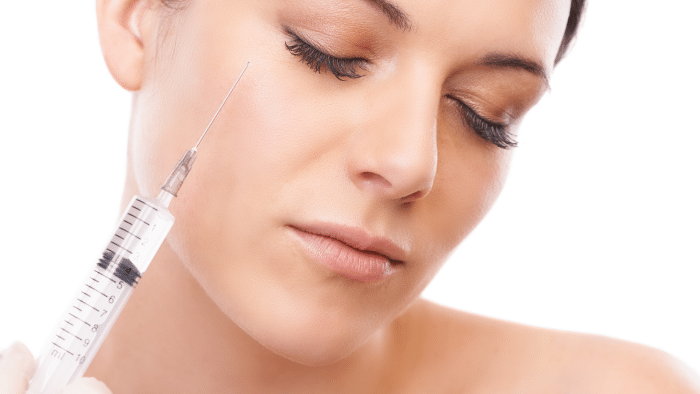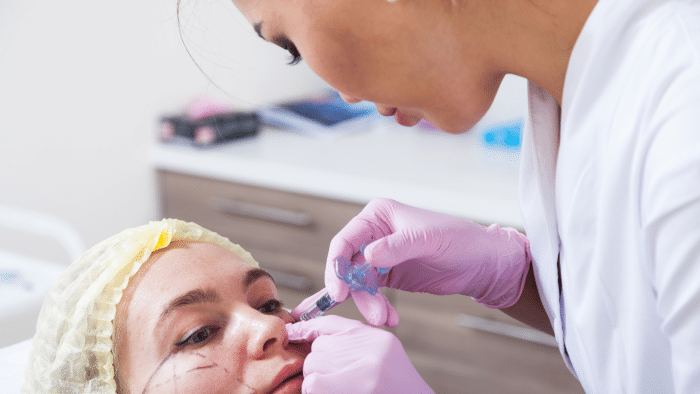
A 2023 study found high patient satisfaction with Botox treatments. One month after receiving injections, 90% of participants reported happiness with the natural-looking results achieved through Botox. The study also revealed that millennials had higher satisfaction with the procedure, showcasing Botox’s broad appeal across generations.
Botox is a purified protein used for temporary cosmetic improvements. By injecting tiny amounts into targeted facial muscles, it disrupts the communication between nerves and muscles, causing them to relax. This relaxation reduces the muscle contractions that cause wrinkles to form and deepen, leaving you with a smoother, more youthful appearance.
This article will delve deeper into the science behind Botox’s rapid results. We’ll explore how it interacts with your body and the factors influencing how long those results last.
Key Takeaways
- Botox injections are known for their rapid onset of action, often producing visible improvements within a few days of treatment.
- The neurotoxin in Botox works by blocking signals that trigger muscle contractions, relaxing facial muscles, and reducing the appearance of dynamic wrinkles.
- Factors such as injection technique, dosage, and the healthcare provider’s expertise can influence the speed and efficacy of Botox’s results.
- Seeking treatment from a qualified and experienced professional is crucial for achieving optimal results with Botox treatment.
The Science Behind Botox’s Rapid Results
Botox injections contain a highly purified botulinum toxin protein that temporarily halts the release of acetylcholine, a neurotransmitter responsible for triggering muscle contractions. This blockage prevents muscles from contracting, which is particularly useful in the facial area, where expressions can lead to wrinkles over time.
With the underlying muscles relaxed, the skin above them becomes smoother, reducing the appearance of dynamic wrinkles. These wrinkles result from repetitive facial movements, such as frowning or smiling. Furthermore, scientific evidence suggests that Botox treatments may stimulate collagen production. Increased collagen in the body may contribute to the skin’s overall youthful appearance and prolong the treatment’s effects.
The combination of these actions contributes to the rapid results observed after Botox treatments, as the changes in muscle activity lead to visible improvements in the skin’s appearance.
Factors Influencing Botox’s Speed and Efficacy

Immediate results from these treatments and Botox’s maximum effects don’t exclusively depend on the product itself. The technique used during the injection process plays a pivotal role in the success of Botox treatments. Here’s why:
- Impact of the Injector’s Expertise: A skilled and experienced injector deeply understands facial anatomy and knows precisely where to place the Botox for optimal results. They can target the specific muscles responsible for wrinkles with accuracy, maximizing the effectiveness of the treatment. An inexperienced injector may not achieve the desired muscle relaxation, leading to less noticeable results or unevenness.
- Quality of the Botox Product Used: Using a genuine Botox product is crucial. Reputable clinics will only use FDA-approved Botox from reliable sources. Lower-quality products may be less effective or even raise the risk of complications.
Specific Areas Targeted for Treatment
The speed at which Botox takes effect can vary depending on the targeted area. This variation is primarily due to the differences in muscle size, depth, and function. Here’s a more detailed breakdown of how Botox’s speed and efficacy can differ based on the targeted area:
- Crow’s Feet: These wrinkles form on the outer corners of the eyes due to repeated squinting. The muscles around the eyes are relatively small and superficial, allowing Botox to block nerve signals and achieve relaxation quickly. This effect leads to a visible smoothing of the crow’s feet within a few days.
- Forehead Lines: Horizontal lines across the forehead appear due to raising eyebrows. The frontalis muscle, responsible for these lines, is also relatively thin and easily accessible. Botox injections in this area can effectively relax the muscles and diminish forehead lines within a week.
These two areas deliver faster results, usually a week or less after the initial treatment. However, injecting Botox in specific regions can have slower results (7-14 days), such as the concerns listed below:
- Glabellar Lines (Frown Lines): These vertical lines form between the eyebrows due to frowning. The muscles responsible (corrugator supercilii and procerus) are slightly thicker than those around the eyes and may require more time for Botox to relax them fully. Additionally, the deeper location of these muscles might influence the speed at which the product diffuses and takes effect.
The Role of Qualified Healthcare Providers in Botox Treatment

While Botox might seem like a simple injection procedure, it requires a deep understanding of facial anatomy, muscle function, and potential side effects. Here’s why choosing a qualified and experienced provider is vital:
- Safe and Effective Injections: A skilled injector possesses a precise knowledge of facial muscles and their connection to wrinkles or targeted areas. This strategy allows them to pinpoint injection sites accurately for optimal results and minimal risk of complications. Improper injection placement can lead to uneven results, muscle weakness, or drooping eyelids.
- Minimizing Side Effects: Botox, like any medical intervention, can have potential side effects, although typically mild and temporary. A qualified provider can reduce these risks through proper technique, dosage selection, and careful consideration of your medical history. They can also effectively manage any side effects that might arise.
- Individualized Treatment Plans: No two faces are alike, and neither should be your Botox treatment plan. A qualified provider will take the time to understand your aesthetic goals, medical history, and facial anatomy. They can then tailor the dosage, injection points, and treatment plan to address your needs and achieve the desired natural-looking results.
- Understanding Long-Term Effects: Botox is not a permanent solution; its effects typically wear off within 3-6 months. A qualified provider can discuss the expected longevity of your results and develop a treatment schedule that aligns with your goals. They can also advise on potential long-term effects and answer any questions.
Factors to Consider When Choosing a Healthcare Provider for Botox Injections
Selecting the right healthcare provider for Botox injections is a decision you should take seriously. Here are some key factors to consider:
- Board Certification: Ensure your provider is a licensed physician, dentist, nurse practitioner, or physician assistant with board certification in their respective field. Look for professionals specializing in aesthetics or dermatology with extensive experience with facial anatomy and Botox injections.
- Experience with Botox: Experience matters! Inquire about the provider’s experience level with Botox injections. Look for someone who regularly performs Botox procedures and has a proven track record of successful outcomes.
- Reviews and Recommendations: Researching online reviews and asking trusted friends or family members for recommendations can be helpful. Positive feedback from previous patients can provide valuable insights into the provider’s skills and bedside manner.
- Facility and Equipment: Choose a provider who works in a clean, professional, and well-equipped medical facility. Proper sterilization techniques and high-quality equipment are essential for safe and effective treatment.
Considerations and Potential Candidates for Botox Treatments

One of the most common considerations when contemplating Botox treatments is determining the age to begin. The question of “what age to start Botox” does not have a one-size-fits-all answer, as it largely depends on individual goals and skin concerns.
For those looking to use Botox as a preventative measure to stave off the formation of wrinkles, starting treatments in the late 20s to early 30s is often recommended. This proactive approach can help minimize the development of deep-set lines and maintain a youthful appearance for longer.
On the other hand, individuals in their late 30s to 40s may consider Botox for maintenance purposes. At this stage, Botox can help smooth out existing lines and prevent new ones from becoming more pronounced. But it’s never too late to start Botox treatments. Those 50 or older can still experience significant benefits from this treatment, especially when treating deeper lines or wrinkles.
Maintaining Your Botox Results
To ensure the longevity of your Botox results and maintain the youthful appearance it provides, consider the following tips:
- Stay Hydrated and Follow a Healthy Diet: Keeping your skin hydrated is essential for maintaining its elasticity and overall health, which can help prolong the effects of Botox. Moreover, eating a balanced diet rich in fruits, vegetables, and whole grains gives your body the nutrients needed to maintain healthy skin.
- Stay Stress-Free: High-stress levels can negatively impact your skin’s health. Finding ways to manage stress effectively can be beneficial for maintaining Botox results.
- Follow Post-Treatment Instructions: Your healthcare provider will provide specific instructions after your Botox treatment. These instructions may include avoiding strenuous activities, rubbing or massaging the injection sites, and lying flat for a certain period to ensure the Botox settles properly and achieves optimal results.
- Get Touch-Up Treatments: As the effects of Botox wear off, wrinkles may begin to reappear. Scheduling touch-up appointments with your healthcare provider can help maintain a consistently smooth appearance. Discuss a personalized treatment plan with your provider to determine the optimal timing for touch-up injections.
- Consider Complementary Treatments: Botox can be combined with other cosmetic procedures like dermal fillers or skincare routines to achieve optimal results. Consult with your healthcare professional to explore if complementary treatments could further enhance and extend the visible improvements from Botox.
Conclusion
The rapid results of Botox injections are a testament to its innovative mechanism of action. Botox offers a visible path to a smoother, more youthful appearance by temporarily relaxing targeted muscles and potentially encouraging collagen production. Moreover, choosing a skilled and experienced healthcare provider is crucial for maximizing the effectiveness and safety of your treatment.
Understanding the science behind Botox and the factors influencing its success enables you to make informed decisions about your cosmetic goals. Empowered with this knowledge, you can embark on a personalized path toward achieving a refreshed, more confident you.
About: DoctorMedica is your trusted supplier of top-quality dermal fillers, viscosupplements, and more for your medical practice. We offer genuine products from leading brands at the lowest prices in the market. Whether you need a specific product or various options, we can help you find the best deals for your needs. Plus, you can enjoy our promotions and free shipping for orders over $500. With DoctorMedica, you can offer your patients the best results for less.
FAQs
1. How soon can I see results from Botox injections?
You can see visible results from Botox injections within a few days to a week, with maximum effects achieved in 10 to 14 days.
2. What should I avoid doing before getting Botox?
In the week leading up to Botox, avoid certain medications and blood thinners that can increase bruising, like aspirin or ibuprofen. You should also skip alcohol for a few days beforehand.
3. Is Botox permanent?
Botox is not permanent. It relaxes muscles temporarily, typically lasting 3-6 months. You’ll need touch-up injections to maintain the results.
References
Dayan SH, Ogilvie P, Boyd CL, et al. Self‐perception of natural outcome, appearance, and emotional well‐being after OnabotulinumtoxinA treatment for upper facial lines: Post hoc analysis across age and gender. Journal of Cosmetic Dermatology. 2023;23(1):107-116. doi:10.1111/jocd.15947
Humphrey S, Jacky B, Gallagher CJ. Preventive, cumulative effects of botulinum toxin type A in facial aesthetics. Dermatologic Surgery. 2017;43(3):S244-S251. doi:10.1097/dss.0000000000001404
Related Articles
Joanna Carr
Is Nucleofill FDA Approved?
The FDA requires rigorous clinical trials and extensive safety data before approving any injectable treatments for use in the U.S.
Joanna Carr
BioRePeel vs PRX-T33 – Do They Complement Each Other?
Discover how BioRePeel and PRX-T33 differ in formulation, depth, and skin concerns -- and whether combining them can enhance rejuvenation results.
Joanna Carr
Artefill Vs Juvederm: Similarities And Differences Explained
Have an interest in learning about The Similarities And Differences of Artefill Vs Juvederm Explained? Browse Doctor Medica's extensive archive of blo...


